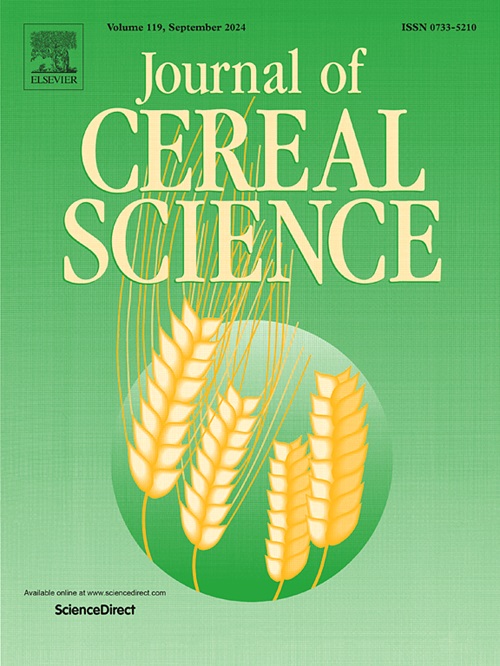Impact of processing methods on the rheological and mineral profiles of end products from traditional and novel durum wheat (Triticum turgidum spp. durum) genotypes
IF 3.7
2区 农林科学
Q2 FOOD SCIENCE & TECHNOLOGY
引用次数: 0
Abstract
To face climate change and ensure food security, particularly in vulnerable regions like the Mediterranean, it is essential to identify drought-tolerant, nutrient-rich durum wheat varieties. This study investigated the impact of processing methods on the rheological, technological, and nutritional properties of grain, flour and pasta from novel and traditional durum wheat genotypes. Two novel drought-tolerant genotypes, LcyE A−B- and Svevo 1BL.1RS, and their wild-type controls, Kronos and Svevo, were evaluated. Traditional semolina milling was compared with an innovative micronization and air separation system for semi-integral flour production. Significant genotypic variation in grain elemental composition was observed, with LcyE A−B- exhibiting superior accumulation of essential nutrients, especially Fe, Mo, Ca, Mn, and Zn. Rheological and technological analyses revealed that coarse fractions, due to bran presence, generally exhibited lower gluten quality and altered dough behaviour compared to semolina. Notably, the 1BL.1RS translocation, while potentially beneficial for drought tolerance, negatively impacted gluten strength in Svevo 1BL.1RS, but did not compromise kernel hardness. Indeed, grain hardness values remained within or above the range for high-quality semolina production. Pasta quality assessments indicated that semolina pasta generally displayed better firmness, while coarse fraction pasta had reduced stickiness and improved bulkiness due to bran's water-retention capacity. Ionomic profiling showed that processing significantly influenced nutrient distribution, with LcyE A−B- maintaining high Fe and Zn concentrations in coarse fraction flour, but not in semolina. Coarse fraction pasta generally exhibited higher nutrient levels, particularly Fe and Zn in both Svevo and LcyE A−B-. These findings suggest that semi-integral flour production could be a viable strategy for improving the nutritional profile of pasta, especially when utilizing genotypes with enhanced nutrient accumulation. However, the success of this approach hinges on optimization of processing methods. This is particularly critical for genotypes like Svevo 1BL.1RS with gluten quality limitations. Future research should focus on refining milling and pasta-making techniques to maximize the technological and nutritional potential of these novel durum wheat lines while preserving their drought resilience.
加工方法对传统和新型硬粒小麦(Triticum turgidum spp. durum)基因型最终产品流变学和矿物特征的影响
为了应对气候变化并确保粮食安全,特别是在地中海等脆弱地区,确定耐旱、营养丰富的硬粒小麦品种至关重要。本研究研究了不同加工方法对新型和传统硬粒小麦基因型谷物、面粉和面食流变学、工艺和营养特性的影响。两种新的耐旱基因型LcyE A−B-和Svevo 1BL。对1RS及其野生型对照Kronos和Svevo进行评价。将传统的小麦粉制粉与新型的微粉空分制粉系统进行了比较。籽粒元素组成存在显著的基因型差异,LcyE A−B-表现出更强的必需营养素积累,特别是铁、钼、钙、锰和锌。流变学和技术分析表明,与粗面粉相比,由于麸皮的存在,粗颗粒通常表现出较低的面筋质量和改变的面团行为。尤其是1BL。1RS易位虽然对sevo 1BL的耐旱性有利,但对面筋强度有负面影响。但不影响果仁硬度。事实上,颗粒硬度值保持在或高于高质量粗粒粉生产的范围内。面食质量评估表明,粗粒面粉面食通常表现出更好的硬度,而粗粒面食由于麸皮的保水能力而降低了粘性并改善了体积。基因组分析表明,加工对营养成分的分布有显著影响,LcyE A−B-在粗粒面粉中保持较高的铁和锌浓度,而在粗粒面粉中则没有。粗粒面食的营养成分含量普遍较高,特别是铁和锌在sevo和LcyE A−B-中含量较高。这些发现表明,半整体面粉生产可能是改善面食营养状况的可行策略,特别是当利用营养积累增强的基因型时。然而,这种方法的成功取决于加工方法的优化。这对于像Svevo 1BL这样的基因型尤其重要。1RS具有面筋质量限制。未来的研究应侧重于改进碾磨和面食制作技术,以最大限度地发挥这些新型硬粒小麦品系的技术和营养潜力,同时保持其抗旱性。
本文章由计算机程序翻译,如有差异,请以英文原文为准。
求助全文
约1分钟内获得全文
求助全文
来源期刊

Journal of Cereal Science
工程技术-食品科技
CiteScore
7.80
自引率
2.60%
发文量
163
审稿时长
38 days
期刊介绍:
The Journal of Cereal Science was established in 1983 to provide an International forum for the publication of original research papers of high standing covering all aspects of cereal science related to the functional and nutritional quality of cereal grains (true cereals - members of the Poaceae family and starchy pseudocereals - members of the Amaranthaceae, Chenopodiaceae and Polygonaceae families) and their products, in relation to the cereals used. The journal also publishes concise and critical review articles appraising the status and future directions of specific areas of cereal science and short communications that present news of important advances in research. The journal aims at topicality and at providing comprehensive coverage of progress in the field.
 求助内容:
求助内容: 应助结果提醒方式:
应助结果提醒方式:


